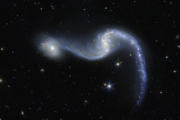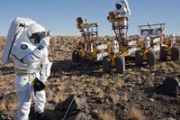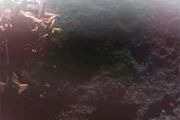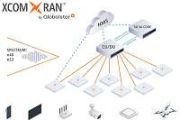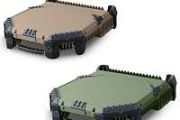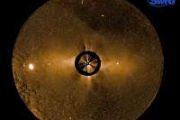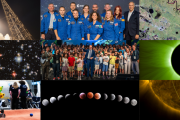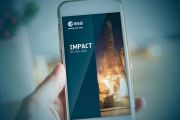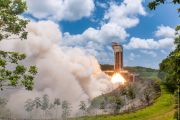
Copernical Team
NASA says asteroid 2024 YR4 size of a 10-story building; increases chances of moon impact
 NASA said that an asteroid previously believed to be destined for Earth is the size of a 10-story building and is now more likely to make impact with the moon.
Designated as near-Earth asteroid 2024 YR4, both NASA observers and members of the worldwide planetary defense community felt at first that the object, said to be 174-220 feet in size, might hit the Earth in 2032.
Those sa
NASA said that an asteroid previously believed to be destined for Earth is the size of a 10-story building and is now more likely to make impact with the moon.
Designated as near-Earth asteroid 2024 YR4, both NASA observers and members of the worldwide planetary defense community felt at first that the object, said to be 174-220 feet in size, might hit the Earth in 2032.
Those sa Galaxies stopped growing sooner than cosmic models predict
 For decades, astronomers believed that only star-forming galaxies populated the earliest epochs of the Universe. But new data from the James Webb Space Telescope (JWST) has overturned this expectation, revealing galaxies that halted star formation far earlier than previously imagined. In a major finding, a global team led by University of Geneva (UNIGE) researchers has identified the most distan
For decades, astronomers believed that only star-forming galaxies populated the earliest epochs of the Universe. But new data from the James Webb Space Telescope (JWST) has overturned this expectation, revealing galaxies that halted star formation far earlier than previously imagined. In a major finding, a global team led by University of Geneva (UNIGE) researchers has identified the most distan The Biggest Challenges Facing Space Exploration Today
 While space exploration has always pushed the boundaries of human knowledge, complex challenges have always emerged as we go further. There are many obstacles, from the harsh realities of space travel to the limitations of current technology.
As space agencies and private companies push missions to space, overcoming these challenges is becoming increasingly important. So, let's explore the
While space exploration has always pushed the boundaries of human knowledge, complex challenges have always emerged as we go further. There are many obstacles, from the harsh realities of space travel to the limitations of current technology.
As space agencies and private companies push missions to space, overcoming these challenges is becoming increasingly important. So, let's explore the Webb telescope captures images, insight from one of Milky Way's most extreme environments
 Sagittarius C is one of the most extreme environments in the Milky Way Galaxy. This cloudy region of space sits about 200 light-years from the supermassive black hole at the center of our galaxy. Here, a massive and dense cloud of interstellar gas and dust has collapsed on itself over millions of years to form thousands of new stars.
In a new study, a team of scientists used observations f
Sagittarius C is one of the most extreme environments in the Milky Way Galaxy. This cloudy region of space sits about 200 light-years from the supermassive black hole at the center of our galaxy. Here, a massive and dense cloud of interstellar gas and dust has collapsed on itself over millions of years to form thousands of new stars.
In a new study, a team of scientists used observations f SpaceX launches next round of Internet satellites from California
 With patches of blue sky peeking through a mostly overcast sky, SpaceX launched 27 Starlink Internet satellites into low-Earth orbit aboard a Falcon 9 rocket from Vandenberg Space Force Base in California just after 6 pm PDT Thursday.
It's the 5th time this first stage fuel booster cell has been used to launch a SpaceX rocket. The booster landed on the recovery droneship Of Course I Sti
With patches of blue sky peeking through a mostly overcast sky, SpaceX launched 27 Starlink Internet satellites into low-Earth orbit aboard a Falcon 9 rocket from Vandenberg Space Force Base in California just after 6 pm PDT Thursday.
It's the 5th time this first stage fuel booster cell has been used to launch a SpaceX rocket. The booster landed on the recovery droneship Of Course I Sti Sidus Space expands $120M lunar satellite deal with Lonestar
 Sidus Space (NASDAQ: SIDU) has finalized an expanded preliminary agreement with Lonestar Data Holdings, extending a collaborative initiative now valued at around $120 million. This enhanced partnership charts the course for the development, deployment, and operational support of six lunar-based data storage satellites, pushing the boundaries of secure information retention infrastructure beyond
Sidus Space (NASDAQ: SIDU) has finalized an expanded preliminary agreement with Lonestar Data Holdings, extending a collaborative initiative now valued at around $120 million. This enhanced partnership charts the course for the development, deployment, and operational support of six lunar-based data storage satellites, pushing the boundaries of secure information retention infrastructure beyond Sateliot secures major backing to scale 5G IoT satellite network
 Sateliot has finalized a euro 70 million Series B funding round, reinforcing its role as the first 5G IoT mobile operator delivering connectivity from space. The company uses an innovative low-Earth orbit (LEO) satellite constellation to provide cost-effective global Internet of Things (IoT) services, enabling coverage where traditional networks fall short.
The newly raised capital will a
Sateliot has finalized a euro 70 million Series B funding round, reinforcing its role as the first 5G IoT mobile operator delivering connectivity from space. The company uses an innovative low-Earth orbit (LEO) satellite constellation to provide cost-effective global Internet of Things (IoT) services, enabling coverage where traditional networks fall short.
The newly raised capital will a How to engineer microbes to enable us to live on Mars
 Associate Tutor and PhD Candidate in Philosophy of Science, Manchester Metropolitan University
A field known as synthetic biology has become one of the most highly anticipated in science. Its outputs range from golden rice, which is genetically engineered to provide vitamin A, to advances stemming from the Human Genome Project, which successfully mapped the entire human genome. Prominent v
Associate Tutor and PhD Candidate in Philosophy of Science, Manchester Metropolitan University
A field known as synthetic biology has become one of the most highly anticipated in science. Its outputs range from golden rice, which is genetically engineered to provide vitamin A, to advances stemming from the Human Genome Project, which successfully mapped the entire human genome. Prominent v Eutelsat expands airborne internet with operational LEO service for aircraft
 Eutelsat has officially launched its OneWeb-powered low Earth orbit (LEO) connectivity services for both commercial and private aircraft, with over 100 certified antennas now installed and the first aircraft already flying with active LEO internet connections.
In addition to its longstanding geostationary (GEO) satellite offerings, Eutelsat is delivering a hybrid multi-orbit model to the a
Eutelsat has officially launched its OneWeb-powered low Earth orbit (LEO) connectivity services for both commercial and private aircraft, with over 100 certified antennas now installed and the first aircraft already flying with active LEO internet connections.
In addition to its longstanding geostationary (GEO) satellite offerings, Eutelsat is delivering a hybrid multi-orbit model to the a Amazon prepares to launch first full batch of Project Kuiper satellites
 Amazon's Project Kuiper said Wednesday it is planning to launch 27 satellites April 9 from Cape Canaveral Space Force Station, Florida.
It is the project's first full batch of Internet connection satellites and will be launched by United Launch Alliance.
According to Project Kuiper their first-generation satellite system will put a total of 3,200 into orbit in the first constella
Amazon's Project Kuiper said Wednesday it is planning to launch 27 satellites April 9 from Cape Canaveral Space Force Station, Florida.
It is the project's first full batch of Internet connection satellites and will be launched by United Launch Alliance.
According to Project Kuiper their first-generation satellite system will put a total of 3,200 into orbit in the first constella 




